MidLifeChemist
Hazard to Others
  
Posts: 192
Registered: 4-7-2019
Location: West Coast USA
Member Is Offline
Mood: precipitatory
|
|
Experiment report: Iodine from KI, HCl, H2O2
Here's a report on a simple but fun reaction I performed in my new "home lab" I very recently put together in my garage.
REACTANTS: Potassium Iodide (bought 100 grams on Ebay $17), 8 grams; distilled water, 6ml; HCl from the hardware store, 7.2ml;
chilled 3% H2o2 (99 cents at Target) - 55ml
I dissolved the KI in the water in a 100ml beaker, then added the HCl which produced a slightly yellow solution. Then the H2O2 was added, the mixture
was stirred with my stirring rod, and a good amount of elemetnal Iodine was produced, which quickly settled to the bottom.
As I don't have graduated cylinders or good pipettes, I used my scale to determine when I added the appropriate ml of water, HCl and H2O2 by
approximating 1 gram = 1ml which was quick and easy. It's not exact but I think it was close enough for this experiment.
Btw, I always seem to spill a little HCl when pouring it out of the large gallon jug from the hardware store.. I really need to transfer some into a
smaller, more "pourable" container. For this experiment, I first poured (spilled) some HCl from the gallon jug into an empty 50mm beaker, and then
used an eyedropper to transfer the correct amount from the 50mm beaker into the 100mm beaker with the KI solution in it.
FILTERING: My 110mm porcelain Buchner funnel vacuum filtration set with hand pump ($89 for the vacuum flask, funnel, filter paper,
tubing and hand pump - very happy with the quality) was all set up ready to go, so I filtered the solution with as strong of a vacuum as I could
create. Getting all the Iodine out of the beaker was more difficult than I thought as it stuck to the bottom, but a few washes with cold distilled
water in a wash bottle did the trick.
I'm not sure if there is a better way to get precipitate off the filter paper besides scraping it off. I want to get as much as possible off, but I
worry that if I scrape too hard I'll scrape off some of the paper, which I've probably done in tiny amounts. I *love* my vacuum filtration set and
find it very easy to use, I've had zero problem creating a vacuum. I'm happy I spent the money on it - but I do find the 110mm funnel too large for
small amounts of precipitate, anything less than a few grams will probably be spread too thin on the filter paper, as I found out with the Lead Iodide
I produced last week doing the "Golden Rain" experiment.
After keeping the vacuum for a few more minutes to dry it out as much as possible, I used a small spatula (courtesy of Deschem) to scrape the Iodine
off the filter paper onto a watch glass. I let it sit out for 30 more minutes, and it seemed pretty dry so I transferred it into a small HEPA bottle
and put it into my "lab fridge" (aka old frig in the garage).
All this was done in the garage with the door open and a fan on. I didn't notice any chlorine smell but my wife said she smelled a little.
RESULTS: The weight of the Iodine was 5.5 grams which represented a 90% yield. I'm sure the Iodine still has some moisture in it, so
the actual yield is probably a little less. I looked up the solubility of Iodine in water, and it is quite low, so I should be able to get this yield
even higher in the future.
I've read about different techniques to dry out the Iodine or purify it but I was fine with what I had.
CLEANUP: Now it was cleanup time, I had Iodine or Iodine-water in several places, and I had spilled a little bit here and there, and
had a stain on my finger. Also, the tubing from my filtration flash to the hand pump was quite discolored.
I prepared a plastic tub of Sodium Thiosulfate solution (courtesy of Photographer's formulary - $9 for 454 grams of anhydrous) which nicely took care
of all my cleanup. Interestingly, when I added some NaS2O3 powder to the filtrate in my vacuum filtration flask - which should have been a KCl
solution with a little Iodine in solution, a white precipitate formed which I'm not exactly sure what it was.
I did notice that my steel spoon/spatula from Deschem was quite discolored from being in contact with the Iodine, which is a shame because it was
brand new.
And that's it. A simple experiment but easy and I highly recommend it to anyone who hasn't tried it. As always, any comments, tips, or advice is
appreciated. And I'm looking forward to trying some reactions with my elemental Iodine!
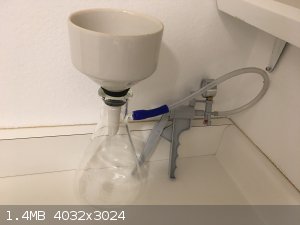
Here's the filtration setup that allowed me to dry the Iodine quickly. The setup, with a 110ml funnel and a 1000ml beaker, is a little large, but it
is high-quality and I'm sure i'll be glad I have the larger size when I need it. Worse case, in the future I'll pick up a smaller buchner funnel as
long as it will fit the flask opening. i've been very happy with how this particular plastic hand pump has been working.
[Edited on 11-10-2020 by MidLifeChemist]
|
|
|
Lion850
National Hazard
   
Posts: 517
Registered: 7-10-2019
Location: Australia
Member Is Offline
Mood: Great
|
|
Thank you for the interesting report. If you are like me and simply enjoy making Colourful salts that looks nice consider antimony iodide; it’s
quite beautiful.
|
|
|
BackyardScience2000
Harmless

Posts: 5
Registered: 10-9-2019
Member Is Offline
|
|
Interesting. Thank you for being so thorough with your report. I also agree that antimony iodide is a good salt to make. What do you plan to use
your iodine for? Just random experiments like I do?
|
|
|
Housane
Hazard to Others
  
Posts: 127
Registered: 3-9-2018
Location: Worcester, England
Member Is Offline
Mood: Let’s make
|
|
Thanks for such an in-depth lab report, another experiment to add to the list
Green QD's so far
Feel free to correct grammar or incorect knknowledge. We are all learning.
|
|
|
EthidiumBromide
Harmless

Posts: 42
Registered: 27-9-2020
Member Is Offline
Mood: Effervescent
|
|
Nice experiment, MidlifeChemist. On top of the suggested antimony iodide, I can highly recommend making some tin(IV) iodide (SnI4) - the procedure is
described on Woelen's website among other places and it has some pretty interesting properties, being a low melting, low boiling covalent compund.
Quote: Originally posted by MidLifeChemist  | Interestingly, when I added some NaS2O3 powder to the filtrate in my vacuum filtration flask - which should have been a KCl solution with a little
Iodine in solution, a white precipitate formed which I'm not exactly sure what it was.
[Edited on 11-10-2020 by MidLifeChemist] |
This is just a guess, but perhaps the thiosulfate reacted with some residual HCl and had formed a colloidal suspension of sulfur. Such a suspension
won't settle out that easily and when you shine a light through the suspension you get the so-called Tyndall effect.
Perhaps it was something else, just the first thing that popped up in my head.
|
|
|
Texium
Administrator
       
Posts: 4580
Registered: 11-1-2014
Location: Salt Lake City
Member Is Offline
Mood: PhD candidate!
|
|
Great job on the experiment and thorough write-up!
If you run this experiment again, I would recommend using sulfuric acid in place of HCl. As a general rule, I always avoid mixing halogens when
possible, because they can react with one another to form interhalogens. In this case you could have some ICl and potentially ICl3 form,
which would lower your yield and potentially contaminate your product. The use of sulfuric acid will guarantee that you get pure I2. If you
don’t have sulfuric acid, the most common way to obtain it in the US is as Rooto drain opener, which can be found at Ace Hardware in a gallon jug
for less than $20. It’s ~95% and reasonably pure.
If you find that your Büchner funnel is too large, you can always purchase a smaller one individually to use with the filter flask that you already
have. Eventually you’ll probably want a smaller flask as well though. I believe Dr. Bob should still have lots of sizes of filter flasks available
for just a few bucks a pop, and he may still have various size Büchner funnels as well.
|
|
|
MidLifeChemist
Hazard to Others
  
Posts: 192
Registered: 4-7-2019
Location: West Coast USA
Member Is Offline
Mood: precipitatory
|
|
@Lion850 - thanks for the advice. I might give Antimony Iodide a try. I just read your report. I don't have a reflux setup so I'll have to use a RBF
over a beaker like you did - do you think it works well? would a 280 celsius hot plate be hot enough? And I need to buy some Antimony. Do you think
Xylene would work well? I've seen that in the hardware store. Is DCM available in hardware stores?
@BackyardScience2000 - thanks for the nice comments. I enjoy all types of inorganic chemistry like colorful compounds, transition metal & rare
earth compounds, interesting colors, uncommon cations and anions, and mildly reactive reactions. So yeah, random experiments like you 
@Housane, you are very welcome
@EthidiumBromide - thanks for the suggestion. I agree that both SbI3 and SnI4 look interesting. I don't have Tin powder or CS2 so I'll have to look
into sources. I only have SnCl2. And yeah, the precipitate could have sulfur, honestly I didn't look at it very closely but that is possible and I did
add quite a bit of thiosulfate to the flask.
@Texium - thanks for the nice comments. I do have Rooto drain opener from Ace hardware, paid $10 for it, but I haven't opened it yet  I might try the H2SO4 method in the future. I used HCl because Nurdrage specifically
said the HCl method was less messy, and it's hard for me to do messy experiments right now. Regarding the Buchner funnel, yeah I might get a smaller
one down the road and a smaller flask. I saw Dr Bob's stuff but shipping is from the UK which would probably negate any cost savings, but I'll check
with him! I might try the H2SO4 method in the future. I used HCl because Nurdrage specifically
said the HCl method was less messy, and it's hard for me to do messy experiments right now. Regarding the Buchner funnel, yeah I might get a smaller
one down the road and a smaller flask. I saw Dr Bob's stuff but shipping is from the UK which would probably negate any cost savings, but I'll check
with him!
[Edited on 11-10-2020 by MidLifeChemist]
|
|
|
EthidiumBromide
Harmless

Posts: 42
Registered: 27-9-2020
Member Is Offline
Mood: Effervescent
|
|
For making SnI4 you don't need CS2, which is quite difficult to get - you can use either DCM or chloroform, if you can get that. Small quantities of
chloroform can be obtained by doing the haloform reaction with bleach and acetone - for the purpose of the SnI4 experiment you don't need to redistill
it, but it would be best to dry it over something like anhydrous CaCl2 or MgSO4 to get rid of water which could end up hydrolysing the product.
You can electrolyse aqueous, acidified SnCl2 solutions to obtain beautiful dendritic tin crystals, and after you're done with that collect the tin. It
should work decently enough for the experiment, though obviously tin powder will work better. 
[Edited on 11-10-2020 by EthidiumBromide]
|
|
|
Syn the Sizer
National Hazard
   
Posts: 600
Registered: 12-11-2019
Location: Canada
Member Is Offline
|
|
Well done man.
You could purify your product via sublimation. ICl/ICl3 have a b.p of 97°C. Iodine sublimes at 184°C. It will leave bits of filter paper
behind as well.
Syn'
|
|
|
Lion850
National Hazard
   
Posts: 517
Registered: 7-10-2019
Location: Australia
Member Is Offline
Mood: Great
|
|
"@Lion850 - thanks for the advice. I might give Antimony Iodide a try. I just read your report. I don't have a reflux setup so I'll have to use a RBF
over a beaker like you did - do you think it works well? would a 280 celsius hot plate be hot enough? And I need to buy some Antimony. Do you think
Xylene would work well? I've seen that in the hardware store. Is DCM available in hardware stores?"
MidLifeChemist:
- Using a RBF on top of a beaker does not offer a way to completely prevent interaction with the atmosphere (oxygen or moisture) but it does reduce
the solvent losses. This worked quite well with boiling xylene, BP 139C, but less well with DCM due to the much lower BP of DCM of 39.6C. With xylene,
even when the water in the RBF got near boiling the xylene was still condensing and dripping back. If you have a lot of xylene and you are not too
concerned about the fumes you don't have to use anything; just top up the beaker from time to time. And work in a well ventilated area.
- I think a 280C hot plate is hot enough; also depends on the wattage though.
- As far as I know, in Australia DCM is not readily available in hardware stores. But it can be purchased from some chemical suppliers and some other
solvent suppliers without any difficulty.
- As I mentioned for tin iodide I used DCM and for antimony iodide xylene. Seems that the antimony reacted faster in xylene probably due to the higher
temperature. Tin iodide could probably also be made in xylene, but I am not sure.
- Note I used powdered antimony. With bigger pieces the reaction may take longer.
|
|
|
teodor
National Hazard
   
Posts: 876
Registered: 28-6-2019
Location: Heerenveen
Member Is Offline
|
|
I prepared I2 only once but has some plan to do more experiments in the future. Actually it was not elemental iodine but solution of I2 in KI for
medical purposes. I made it by reaction of CuSO4 and KI and my vacuum filtration was for the purpose to separate CuI precipitate. What was funny is
iodine vapours colour visible only in a silicone tube - it disappeared after filtration was complete (the tube is actually white - like those on a
back side). You can see this moment on the picture.
My next plan is to make more pure iodine and also managing of steam extraction method - I plan to steam extract I2 from solution like that. Also I am
creating plan of playing with CuI, it should be interesting compound by itself.
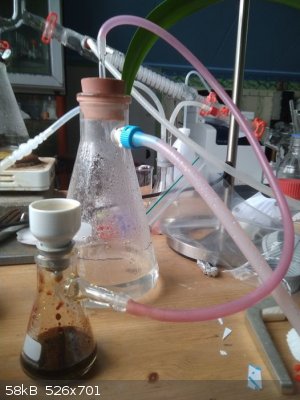
[Edited on 12-10-2020 by teodor]
I wouldn't bother about pieces of paper until you have dust-free environment. As the first improvement in this process I would use a glass filter.
[Edited on 12-10-2020 by teodor]
|
|
|
Texium
Administrator
       
Posts: 4580
Registered: 11-1-2014
Location: Salt Lake City
Member Is Offline
Mood: PhD candidate!
|
|
Quote: Originally posted by MidLifeChemist  | @Texium - thanks for the nice comments. I do have Rooto drain opener from Ace hardware, paid $10 for it, but I haven't opened it yet  I might try the H2SO4 method in the future. I used HCl because Nurdrage specifically
said the HCl method was less messy, and it's hard for me to do messy experiments right now. Regarding the Buchner funnel, yeah I might get a smaller
one down the road and a smaller flask. I saw Dr Bob's stuff but shipping is from the UK which would probably negate any cost savings, but I'll check
with him! I might try the H2SO4 method in the future. I used HCl because Nurdrage specifically
said the HCl method was less messy, and it's hard for me to do messy experiments right now. Regarding the Buchner funnel, yeah I might get a smaller
one down the road and a smaller flask. I saw Dr Bob's stuff but shipping is from the UK which would probably negate any cost savings, but I'll check
with him! |
Well I don't know what Nurd was talking about. Changing the strong acid that you use really
shouldn't make it any messier. At the end of the day it's pretty much the same method. Also, Dr. Bob is in North Carolina! You must have gotten him
mixed up with someone else.
|
|
|
MidLifeChemist
Hazard to Others
  
Posts: 192
Registered: 4-7-2019
Location: West Coast USA
Member Is Offline
Mood: precipitatory
|
|
@EthidiumBromide - thanks, I think i'll try the SnCl2 electrolysis, the tin crystals look beautiful. Since I can buy Xylene, I might try it with both
Sb and Sn
@SynSizer - thanks for the nice words and advice. I may try purifying it in the future, but it's probably fine for the experiments I have in mind the
way it is.
@Lion850 - thanks for the additional tips. My hotplate/stirrer is 600 watts. I can buy Xylene in the hardware store so I might try that with the Sb
and Sn and do the reaction outdoors. Noted on the Antimony powder. I wonder if Antimony ingots can be ground up in a magic bullet blender (not that I
have one yet) or crushed in a mortar/pestle. We'll see - not sure if I want to get Antimony yet as I'm trying to limit the number of toxic chemicals
I use - but I do realize that elemental Antimony is probably not too toxic.
@teodor - thanks for the comments, and for sharing the photos. Your tube looks purple -interestingly my tube turned more brownish than purple.
Regarding filter - are you referring to a fritted glass fitler? I don't have one but would like to try one in the future as it might be nice not to
have to scrape a wet solid off paper. But I've heard glass filters have their own challenges.
|
|
|
teodor
National Hazard
   
Posts: 876
Registered: 28-6-2019
Location: Heerenveen
Member Is Offline
|
|
Quote: Originally posted by MidLifeChemist  |
Regarding filter - are you referring to a fritted glass fitler? I don't have one but would like to try one in the future as it might be nice not to
have to scrape a wet solid off paper. But I've heard glass filters have their own challenges. |
I think yes, fritted glass filter, frankly speaking I have only one type - https://www.laboratorium.shop/product/millipore-glasvezelfil... .
I can use it only with small buchner funnel because it 25mm only but works very well.
I try not to be so greedy to scrape filter anyway - I prefer some loss to contamination. Usually I just allow solid to fall from a filter. I am not
familiar with your problem with iodine but can suppose it is because it oxidises the paper. Or may be your vacuum treatment is not enough to make it
dry?
Also I have idea that the size of the funnel is the thing which matters. Try to use as small as possible to accumulate solid in thick layer. What are
you saying is more likely you have a very thin deposit on a big surface area which is wrong from my point of view.
[Edited on 12-10-2020 by teodor]
Sometimes I intentionally make crystals bigger than pores in the porcelain to use buchner funnel without any filter.
[Edited on 12-10-2020 by teodor]
|
|
|
arkoma
Redneck Overlord
      
Posts: 1761
Registered: 3-2-2014
Location: On a Big Blue Marble hurtling through space
Member Is Offline
Mood: украї́нська
|
|
Keep your eye out for a used vacuum pump. Night and day difference. I have an old Robinair two-stage, with a make-shift water trap, an oil trap in the
exhaust line and the exhaust goes outside. The water trap is a old hospital vacuum collection jar, with the intake run into a HDPE bottle full of dry
MgSO4 which I wrapped a bunch of gauze around. I have pulled some hella vacuum on the jar, but I keep it in a closed steel desk drawer
when in use in case of an implosion.
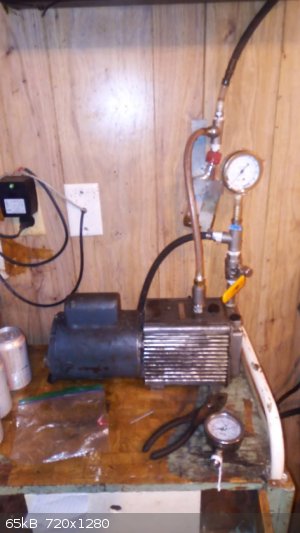 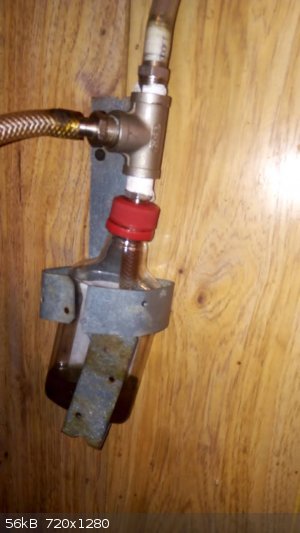 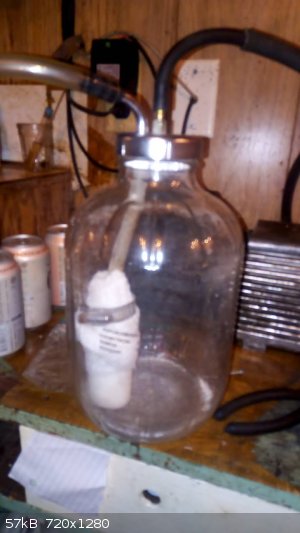
"We believe the knowledge and cultural heritage of mankind should be accessible to all people around the world, regardless of their wealth, social
status, nationality, citizenship, etc" z-lib
|
|
|
zed
International Hazard
    
Posts: 2283
Registered: 6-9-2008
Location: Great State of Jefferson, City of Portland
Member Is Offline
Mood: Semi-repentant Sith Lord
|
|
Ummm. Speaking of Iodine; a while back, I bought a few hundred grams, from a U.S. seller. It arrived in a plastic bag, adorned with Chinese
writing. Oh well.
I never really opened it, but As the months have passed, it has become gloppy. Yup! It seems to be sucking moisture out of the air. Now, I stuck
the whole works in a sealed Mason jar, and put it off in a corner downstairs, but I'm wondering. Did these folks send me high priced Grape Koolaid?
Or, is my Iodine converting itself to soluble form, like I3? I2 isn't very soluble.
Guess I'll go check around.
|
|
|
AJKOER
Radically Dubious
    
Posts: 3026
Registered: 7-5-2011
Member Is Offline
Mood: No Mood
|
|
Try also preparing some I2 (low yield likely) without now hard to find H2O2 and even without HCl!
How? The chemistry is more advanced than most, even on this forum, would believe, so I will give the experimental details and a few hints on the
chemistry possibly at play.
First, my suspicion on the chemical reaction appears to be confirmed, but weakly, in this Wikipedia commentary on MgI2 which is created in the current
context from mixing aqueous Epsom's Salt (as a source of MgSO4) with KI and freezing out the K2SO4:
2 KI + MgSO4 <=> MgI2 + K2SO4
To quote Wikipedia (https://en.wikipedia.org/wiki/Magnesium_iodide ):
"decomposes in air at normal temperatures, turning brown from the release of elemental iodine. When heated in air, it decomposes completely to
magnesium oxide.[4]"
To augment the alluded to chemistry above, try placing your air sensitive, hygroscopic and light sensitive MgI2 per also this source (https://www.fishersci.com/store/msds?partNumber=AA1428303&am...), to quote:
"Storage: Keep containers tightly closed in a dry, cool and well-ventilated place. Keep under nitrogen. Store under an inert atmosphere. Protect from
moisture. "
In an open tray expose to air (or pump air into an aqueous solution where the pH < 4.8, add CO2 if necessary) in the presence of a very small
amount of Aluminum metal, in place of air borne metal oxide particles (and also as the anode in the battery cell akin to the so-called bleach battery,
which is discussed, with summary reaction, at http://www.exo.net/~pauld/saltwater/ but here based on Iodine species) and say pure Copper (or Graphite to serve as the cathode). Note: avoid
significant Al presence as with I2, it will be attacked and consumed forming AlI3 (which with water creates HI).
My quick summary of the underlying galvanic, radical and standard chemistry:
Al -> Al3+ + 3 e- (Anodic corrosion of the Aluminum)
O2 + e- (aq) > •O2- (formation of superoxide radical anion)
where interestingly, ions of Al, Ca and Mg have been cited (see my sources here http://www.sciencemadness.org/talk/viewthread.php?tid=96347#... ) as being able to bond with superoxide, contributing to oxidative stress (per
REDOX chemistry based on the superoxide radical anion) in humans.
Continuing, in acidic pH and in atmospheric (gaseous) conditions (including the air/water interface), superoxide exists as HO2:
H+ + •O2- = •HO2 (pKa 4.88)
where importantly, the hydroperoxyl radical is reported as effective in releasing some elemental halide from their salts (like Br- and I-). Source:
See this work noting free bromine formation (and not complexed), 'Hydroperoxyl radical (•HO2) oxidizes dibromide radical anion (•Br2−) to
bromine (Br2) in aqueous solution: Implications for the formation of Br2 in the marine boundary layer', a work by Brendan M. Matthew, et al, fully
available (for free) at: https://agupubs.onlinelibrary.wiley.com/doi/full/10.1029/200... .
In the current context:
I- + •HO2 = •I + HO2-
•I + •I = I2
H+ (even from water) + HO2- = H2O2
I- (even Cl-) + H2O2 --Copper Ions--> HOI (HOCl) + H2O (Source: See https://pubmed.ncbi.nlm.nih.gov/3009503/ )
Also, the presence of light (especially UV rich) will be advantageous and likely further Fenton-type reactions based on any HOI formation leading also
to the iodine radical (•I at pH < 4.88).
[Edited on 18-10-2020 by AJKOER]
|
|
|